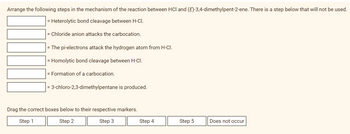Cis-diols are formed when alkenes are reacted with mCPBA and H3O+. Ketones are always produced from the ozonolysis reactions of alkenes. Select one: O Both statements are true. O Both statements are false. O Only the first statement is true. O Only the second statement is true.
Cis-diols are formed when alkenes are reacted with mCPBA and H3O+. Ketones are always produced from the ozonolysis reactions of alkenes. Select one: O Both statements are true. O Both statements are false. O Only the first statement is true. O Only the second statement is true.
Chemistry
10th Edition
ISBN:9781305957404
Author:Steven S. Zumdahl, Susan A. Zumdahl, Donald J. DeCoste
Publisher:Steven S. Zumdahl, Susan A. Zumdahl, Donald J. DeCoste
Chapter1: Chemical Foundations
Section: Chapter Questions
Problem 1RQ: Define and explain the differences between the following terms. a. law and theory b. theory and...
Related questions
Question

Transcribed Image Text:Cis-diols are formed when alkenes are reacted with mCPBA and H3O+. Ketones are always produced from the ozonolysis reactions of alkenes.
Select one:
O Both statements are true.
O Both statements are false.
O Only the first statement is true.
O Only the second statement is true.
Arrange the following steps in the mechanism of the reaction between HCl and (E)-3,4-dimethylpent-2-ene. There is a step below that will not be used.
= Heterolytic bond cleavage between H-CI.
= Chloride anion attacks the carbocation.
= The pi-electrons attack the hydrogen atom from H-CI.
= Homolytic bond cleavage between H-CI.
= Formation of a carbocation.
3-chloro-2,3-dimethylpentane is produced.
Drag the correct boxes below to their respective markers.
Step 1
Step 2
Step 3
Step 4
Step 5
Does not occur
Expert Solution
This question has been solved!
Explore an expertly crafted, step-by-step solution for a thorough understanding of key concepts.
This is a popular solution!
Trending now
This is a popular solution!
Step by step
Solved in 3 steps with 2 images

Follow-up Questions
Read through expert solutions to related follow-up questions below.
Follow-up Question

Transcribed Image Text:Arrange the following steps in the mechanism of the reaction between HCI and (E)-3,4-dimethylpent-2-ene. There is a step below that will not be used.
= Heterolytic bond cleavage between H-CI.
= Chloride anion attacks the carbocation.
= The pi-electrons attack the hydrogen atom from H-CI.
= Homolytic bond cleavage between H-CI.
= Formation of a carbocation.
= 3-chloro-2,3-dimethylpentane is produced.
Drag the correct boxes below to their respective markers.
Step 1
Step 2
Step 3
Step 4
Step 5
Does not occur
Solution
Knowledge Booster
Learn more about
Need a deep-dive on the concept behind this application? Look no further. Learn more about this topic, chemistry and related others by exploring similar questions and additional content below.Recommended textbooks for you

Chemistry
Chemistry
ISBN:
9781305957404
Author:
Steven S. Zumdahl, Susan A. Zumdahl, Donald J. DeCoste
Publisher:
Cengage Learning

Chemistry
Chemistry
ISBN:
9781259911156
Author:
Raymond Chang Dr., Jason Overby Professor
Publisher:
McGraw-Hill Education

Principles of Instrumental Analysis
Chemistry
ISBN:
9781305577213
Author:
Douglas A. Skoog, F. James Holler, Stanley R. Crouch
Publisher:
Cengage Learning

Chemistry
Chemistry
ISBN:
9781305957404
Author:
Steven S. Zumdahl, Susan A. Zumdahl, Donald J. DeCoste
Publisher:
Cengage Learning

Chemistry
Chemistry
ISBN:
9781259911156
Author:
Raymond Chang Dr., Jason Overby Professor
Publisher:
McGraw-Hill Education

Principles of Instrumental Analysis
Chemistry
ISBN:
9781305577213
Author:
Douglas A. Skoog, F. James Holler, Stanley R. Crouch
Publisher:
Cengage Learning

Organic Chemistry
Chemistry
ISBN:
9780078021558
Author:
Janice Gorzynski Smith Dr.
Publisher:
McGraw-Hill Education

Chemistry: Principles and Reactions
Chemistry
ISBN:
9781305079373
Author:
William L. Masterton, Cecile N. Hurley
Publisher:
Cengage Learning

Elementary Principles of Chemical Processes, Bind…
Chemistry
ISBN:
9781118431221
Author:
Richard M. Felder, Ronald W. Rousseau, Lisa G. Bullard
Publisher:
WILEY